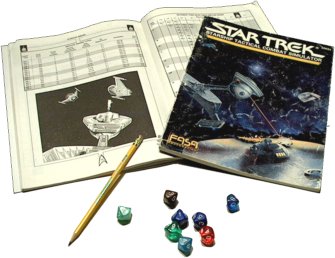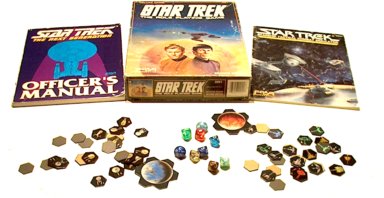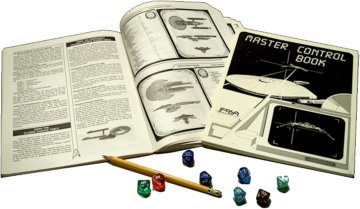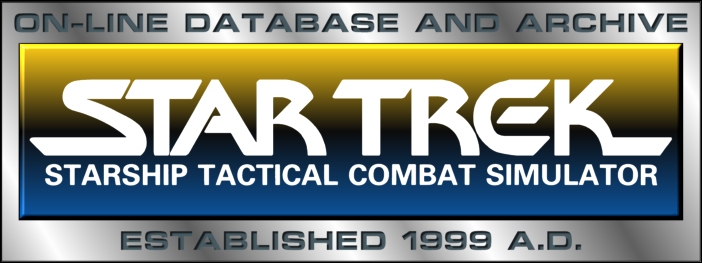|
 hat
the hell is the STAR TREK STARSHIP TACTICAL COMBAT SIMULATOR, anyway??
Well, for those not familiar with the game, the original STSTCS was produced by
role-playing game manufacturer FASA back in the early to mid 1980's, in
the time period between the release of the motion picture Star Trek II:
The Wrath Of Khan, and the release of the motion picture Star
Trek V: The Final Frontier. The STSTCS was a dice, paper, and
cardboard playing piece game that had nothing at all to do with computer
simulations. The game was in its heyday when the
original Apple Macintosh and the Commodore 64 were considered the 'hot'
machines, and the industry as a whole was still a long way away from attaining
the graphics, computational power, or mass digital storage necessary to make
modern space battle and role-playing simulators possible. Essentially, the STSTCS was (and still is) a marvelous game fueled primarily by the imagination
of the players. hat
the hell is the STAR TREK STARSHIP TACTICAL COMBAT SIMULATOR, anyway??
Well, for those not familiar with the game, the original STSTCS was produced by
role-playing game manufacturer FASA back in the early to mid 1980's, in
the time period between the release of the motion picture Star Trek II:
The Wrath Of Khan, and the release of the motion picture Star
Trek V: The Final Frontier. The STSTCS was a dice, paper, and
cardboard playing piece game that had nothing at all to do with computer
simulations. The game was in its heyday when the
original Apple Macintosh and the Commodore 64 were considered the 'hot'
machines, and the industry as a whole was still a long way away from attaining
the graphics, computational power, or mass digital storage necessary to make
modern space battle and role-playing simulators possible. Essentially, the STSTCS was (and still is) a marvelous game fueled primarily by the imagination
of the players.
Man, were those good times or what?
Sadly, they were not to last forever.
 By the time the television series Star
Trek: The Next Generation debuted—riding on the success of the most
popular Star Trek feature film to date, Star Trek IV: The Voyage Home—communication
had faltered between the game creators at FASA and the powers-that-be of Star
Trek. Following a policy that angers me to this day, the
television and film producers of the Star Trek franchise pretty much ignored
or overlooked the STSTCS, just as they have ignored or overlooked
most of the hundreds of Star Trek novels that have been written over the
last fifty years. By the time the television series Star
Trek: The Next Generation debuted—riding on the success of the most
popular Star Trek feature film to date, Star Trek IV: The Voyage Home—communication
had faltered between the game creators at FASA and the powers-that-be of Star
Trek. Following a policy that angers me to this day, the
television and film producers of the Star Trek franchise pretty much ignored
or overlooked the STSTCS, just as they have ignored or overlooked
most of the hundreds of Star Trek novels that have been written over the
last fifty years.
The game producers at FASA tried hard
to make the STSTCS jive with the films and with the new TV series, but it was
awfully difficult considering that the TV and film producers ignored everything
FASA put out. In
the Star Trek world, TV and film have never been expected to support, uphold, or
validate any of the books, manuals, novels, or other
materials that benefit from tie-ins with the large or small screen.
Moreover, there is evidence to
support the claim that Gene Roddenberry himself was behind the death of FASA's
Star Trek license. Always the proclaimed pacifist, and never comfortable
with the military aspect that his self-created "star fleet" implies,
Gene apparently became unhappy with the "militarized" nature of the
FASA role playing universe. (Side note: how Gene expected to film a whole SF
television series set on an armed star vessel—populated by folks with titles
like "Captain" and "Lieutenant", doing galactic battle in
the name of the Federation—and not have it seem "militaristic",
is truly beyond me.)
 In any case, by the end of the 1980's, FASA's entire Star
Trek empire had fallen from grace. Disdained by the franchise creator and
wildly out of step with the rapidly
developing and prospering ST:TNG television series, the STSTCS soon went out of print
along with the rest of the
FASA Star Trek RPG books. There would not be a 3rd edition of the STSTCS.
In any case, by the end of the 1980's, FASA's entire Star
Trek empire had fallen from grace. Disdained by the franchise creator and
wildly out of step with the rapidly
developing and prospering ST:TNG television series, the STSTCS soon went out of print
along with the rest of the
FASA Star Trek RPG books. There would not be a 3rd edition of the STSTCS.
Enter me.
My own collection of FASA Star Trek
material is horribly dog eared. Especially the STSTCS manuals.
Everything is falling apart, and in 1998 I started wondering if I should not try
to find a way to preserve my books; or at least preserve what is printed in
them. I started toying with my computer scanner, loading in some of the
images from the STSTCS and running OCR on the text so that I could load it into
my word processor. My initial plan was to scan in as much of it as I could
and store it on CD-R as .JPG and .TXT files. That way I could make
copies that would be easily moved and that could be kept in safe storage in case
of a fire or other disaster.
Very quickly, however, I discovered
that I was unhappy with the storage format. Jumbling the text and images
together in a file folder made it damned hard to look up information in a
coherent, structured manner. I tried using Microsoft Word to turn it into
.doc files, but even then things felt too clumsy. In some desperation I
realized that my best bet would be to assemble the text and images in .html
format, with all the powerful graphical and hypertext tools of the Web Browser
at my command. I built a few rudimentary pages and an index on my hard
disk, struggling to maintain the images and text on-screen as they had appeared
on paper. Before long my local .html database of STSTCS material began to grow rather
large and, I hate to say, rather lonely.
You see, I don't like working on big
projects without being able to share the results. Especially something
like the STSTCS, which by its very nature requires multiple participants.
I started to feel like I was assembling all this material for no good reason at
all, and at one point I almost chucked the whole project on account of
waning interest, until I was struck by the idea that I ought to open my files up
on the internet and really share them.
I was not too sure that
anybody still played or knew about the STSTCS, but I reasoned that perhaps a
handful of die-hard fans were out there somewhere and might appreciate the
database I was assembling.
I've been building web pages since
1996, slowly sharpening my skills from horrible to average. Being an inveterate graphic
artiste I seized
upon the notion that I ought to really dress up my STSTCS files and create a whole new web site dedicated to the
STSTCS. The site would be an archive for old material, yes, but it would
also be an active clearinghouse wherein I could post new ships of my own creation, new ships from the
evolving movies and new
television series, other fan designs, new rules, general rants, et cetera, et
cetera.
 So in summer of 1999 I set to work on the rough draft of
what was then called the STSTCS Millennium Update & Archive. Yes I know the title
is terribly unwieldy (and still is!) but it's perfectly descriptive just the same! This
is indeed an archive of old and hard to find STSTCS information, along
with continually revised and updated material concerning Star Trek's more
recent developments—developments that FASA never had a chance to explore, such
as the bulk of The Next Generation, all of Deep Space 9, and even
the oft-debated and somewhat apocryphal series Voyager and
Enterprise.
So in summer of 1999 I set to work on the rough draft of
what was then called the STSTCS Millennium Update & Archive. Yes I know the title
is terribly unwieldy (and still is!) but it's perfectly descriptive just the same! This
is indeed an archive of old and hard to find STSTCS information, along
with continually revised and updated material concerning Star Trek's more
recent developments—developments that FASA never had a chance to explore, such
as the bulk of The Next Generation, all of Deep Space 9, and even
the oft-debated and somewhat apocryphal series Voyager and
Enterprise.
The MU&A took on different and
significant cosmetic revisions, first in 2001 and again in 2004. In late
2005, the site title and URL changed, then changed again in 2007, and finally I
set up the permanent domain which you're seeing now, with another
aesthetic alteration. All ship schematics and ship
pages are either in the process of being re-scanned and cleaned up, or have
already been re-rendered in a new, more detailed, hopefully more user-friendly format.
Fan-submitted material has been retained, especially the Jaynz listings and rare
classes from the 1st Edition game sets.
So there we are. I'm trying to
preserve a piece of the past, and at the same time I am trying to bring it into
the future. As hobbies go, there are much worse ones out there. And if
you're one of those rare few who used to have or play the old STSTCS and loved
it as much as I do, I hope you appreciate this web site.
Fire
me e-mail, or visit the
ProBoards
forum, or check in with the
Facebook group. chip in with ideas and what not, maybe a fanship perhaps?
This is a work in progress after all.
2020 Note: a few people have
contacted me to ask about ship stats and schematics for vessels
appearing in any of the three "Kelvin Timeline" films which have come
out since 2009, or the vessels on either Discovery (STD) or
Picard (PIC). I'm going to have to disappoint people and
say, no. With very rare exception—such as when I took the
Kelvin and
adapted it for a ST:TOS scale and aesthetic—I don't touch
anything which has appeared on screen these past dozen years. In
fact, I have serious reservations about both Enterprise and the
Next Generation films. Which is not a knock against the actors or
the people who do the trench work on these productions! It's just
that I don't think the writing or stories stay faithful to the canon.
And while many might argue that ST:TNG needed time to grow on
fans, both Next Generation and Deep Space 9 and even
Voyager all tried to stay consistent with what had gone before.
And since the producers and writers of the new movies and streaming
series don't seem to want to invest in preserving and honoring the
original canon, I don't feel like investing in these particular movies
and series. So again, with rare exception, I don't include them
here.
— Brad R. Torgersen |

